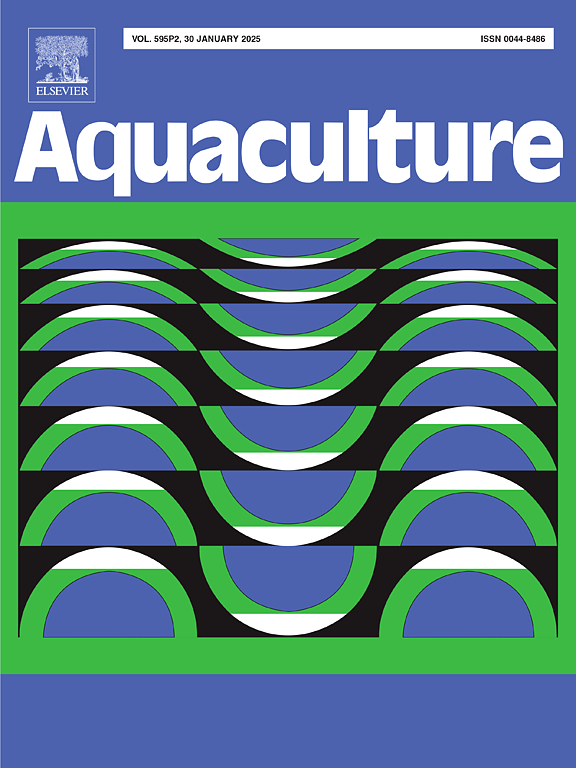Correlation of testicular melatonin and cellular stress in an annual spermatogenic cycle of Clarias batrachus
IF 3.9
1区 农林科学
Q1 FISHERIES
引用次数: 0
Abstract
Melatonin, primarily produced by pineal gland, shows a rhythmic pattern of synthesis in response to environmental cues. Hitherto, the role of testicular melatonin in the regulation of annual spermatogenic cycle is indeterminate in any fish species. Present study aims to explore a correlation, for the first time, of melatonin with cellular stress levels in accordance to the progression of spermatogenesis through six distinct reproductive phases of an annual gonadal cycle of catfish, Clarias batrachus under natural photo-thermal conditions. We assessed gonadosomatic index (GSI), percentage of haploid cells by using DNA intercalating dye in the seminiferous tubules, melatonin concentrations and different intracellular stress parameters in the testis. The concentration of melatonin displayed a distinct seasonal pattern, reaching its peak during the “phase of functional maturity”. Interestingly, the levels of 2′,7′–dichlorofluorescein [reactive oxygen species (ROS) marker], malondialdehyde (MDA) and total nitrate [reactive nitrogen species (RNS)] were found significantly lowered at the verge of “mature state”. Correlation and LOESS (Locally Estimated Scatterplot Smoothing) regression analyses showed a striking positive relationship between testicular melatonin concentration and the activity of antioxidative enzymes, including superoxide dismutase (SOD), catalase (CAT), glutathione peroxidase (GPx) and glutathione S-transferase (GST). Principal component (PC) analysis also identified the key components of “mature state” viz., GSI, testicular melatonin, haploid cell population (spermatid and spermatozoa), and the activity of enzymatic antioxidants. Cumulatively, melatonin may have a role in growth and maturation of spermatogenic cells by reducing cellular stress to augment the quality of germ cells required for seed production in the culture of any fish species.
batrachus每年生精周期中睾丸褪黑素与细胞应激的相关性
褪黑素主要由松果体产生,在环境提示下表现出有节奏的合成模式。迄今为止,睾丸褪黑素在任何鱼类的年度生精周期调节中的作用尚不确定。本研究首次探讨了褪黑激素与细胞应激水平在自然光热条件下,随鲶鱼(Clarias batrachus)一年性腺周期中6个不同生殖阶段精子发生过程的相关性。我们利用精子小管DNA嵌入染料、褪黑激素浓度和不同的细胞内应激参数来评估睾丸的促性腺指数(GSI)、单倍体细胞百分比。褪黑素浓度表现出明显的季节性规律,在“功能成熟期”达到峰值。有趣的是,在“成熟状态”的边缘,2′,7′-二氯荧光素[活性氧(ROS)标记物]、丙二醛(MDA)和总硝酸盐[活性氮(RNS)]的水平显著降低。相关分析和黄土(局部估计散点图平滑)回归分析表明,睾丸褪黑激素浓度与抗氧化酶(超氧化物歧化酶(SOD)、过氧化氢酶(CAT)、谷胱甘肽过氧化物酶(GPx)和谷胱甘肽s -转移酶(GST))活性呈正相关。主成分(PC)分析还确定了“成熟状态”的关键成分,即GSI、睾丸褪黑素、单倍体细胞群(精子和精子)和酶抗氧化剂活性。在任何鱼类的培养中,褪黑素可能通过减少细胞应激来提高种子生产所需的生殖细胞的质量,从而在生精细胞的生长和成熟中发挥作用。
本文章由计算机程序翻译,如有差异,请以英文原文为准。
求助全文
约1分钟内获得全文
求助全文
来源期刊

Aquaculture
农林科学-海洋与淡水生物学
CiteScore
8.60
自引率
17.80%
发文量
1246
审稿时长
56 days
期刊介绍:
Aquaculture is an international journal for the exploration, improvement and management of all freshwater and marine food resources. It publishes novel and innovative research of world-wide interest on farming of aquatic organisms, which includes finfish, mollusks, crustaceans and aquatic plants for human consumption. Research on ornamentals is not a focus of the Journal. Aquaculture only publishes papers with a clear relevance to improving aquaculture practices or a potential application.
 求助内容:
求助内容: 应助结果提醒方式:
应助结果提醒方式:


